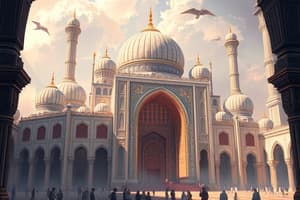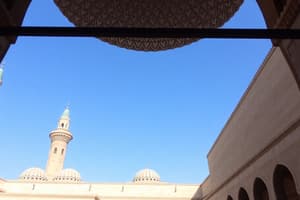Podcast
Questions and Answers
It is also called MUSLIM, MUHAMMADAN, SARACENIC ARCHITECTURE
It is also called MUSLIM, MUHAMMADAN, SARACENIC ARCHITECTURE
ISLAMIC ARCHITECTURE
Belief in Allah, Muhammad as a prophet
Belief in Allah, Muhammad as a prophet
ISLAM
It is a distinct building type
It is a distinct building type
MOSQUE
it believed that object of life is to live in a way that is pleasing to Allah so that one may gain Paradise
it believed that object of life is to live in a way that is pleasing to Allah so that one may gain Paradise
What are the features of Islamic Architecture?
What are the features of Islamic Architecture?
Supports under the domes.
Supports under the domes.
A "Stalactite" decoration of icicle like elements hanging from the ceiling
A "Stalactite" decoration of icicle like elements hanging from the ceiling
Its a Muslim building or place of public worship
Its a Muslim building or place of public worship
MOSQUE is also called ________ or _________
MOSQUE is also called ________ or _________
The four levels of prayers.
The four levels of prayers.
The ultimate architectural espression of the ottoman Kulliye, by Ar. Sinan
The ultimate architectural espression of the ottoman Kulliye, by Ar. Sinan
General term for a mosque and also a mosque used for daily prayers by individuals or small groups.
General term for a mosque and also a mosque used for daily prayers by individuals or small groups.
it has MIHRAB but no MINBAR
it has MIHRAB but no MINBAR
congregational or friday mosque and used for the main weekly services.
congregational or friday mosque and used for the main weekly services.
Usually larger than Masjid and provided with a Minbar
Usually larger than Masjid and provided with a Minbar
a place of community prayer and it has great open praying area with nothing but QUIBLA wall and MIHRAB
a place of community prayer and it has great open praying area with nothing but QUIBLA wall and MIHRAB
Its a teaching mosque
Its a teaching mosque
Tower attached to the mosque, where muezzin calls the Muslim people
to prayer
Tower attached to the mosque, where muezzin calls the Muslim people to prayer
large vaulted portal opening onto the central courtyard of
a mosque
large vaulted portal opening onto the central courtyard of a mosque
pulpit from which the imam delivers his sermons
pulpit from which the imam delivers his sermons
niche or decorative panel
niche or decorative panel
wall in a mosque in which the mihrab is set, oriented to Mecca
wall in a mosque in which the mihrab is set, oriented to Mecca
Atrium
Atrium
Fountain for washing befote prayers
Fountain for washing befote prayers
COLONNADE
COLONNADE
Reading desk
Reading desk
screen, protective barrier of the minbar
screen, protective barrier of the minbar
Also called Masjid Al-Haram
. The largest Mosque in the world
. Site of the Haj Pilgrimage
Also called Masjid Al-Haram . The largest Mosque in the world . Site of the Haj Pilgrimage
Located in Jerusalem. It is influenced by Byzantine Architecture. It used as a shrine for pilgrims and its center is the sacred rock from which
Muhammad is said to have ascended to
heaven. And it has octagonal in Plan
Located in Jerusalem. It is influenced by Byzantine Architecture. It used as a shrine for pilgrims and its center is the sacred rock from which Muhammad is said to have ascended to heaven. And it has octagonal in Plan
“House of God”
• Small cubical stone building
in the courtyard of the Great
Mosque at Mecca
• Contains a sacred black stone
• Objective of their Pilgrimage
• The point toward which they
turn in praying
“House of God” • Small cubical stone building in the courtyard of the Great Mosque at Mecca • Contains a sacred black stone • Objective of their Pilgrimage • The point toward which they turn in praying
Earliest surviving large mosque
. Built in 705-711AD
. Stood in a walled Temenos
Earliest surviving large mosque . Built in 705-711AD . Stood in a walled Temenos
Structural Systems and
decorations adapted from
classical antiquity and
combined with Islamic
Architecture
Structural Systems and decorations adapted from classical antiquity and combined with Islamic Architecture
Building of large Mosques
and elaborate fortress-
palaces
Building of large Mosques and elaborate fortress- palaces
Islamic Architecture of North
Africa
Islamic Architecture of North Africa
Crown Palace
• Built by Shah Jahan as a tomb
for his wife, Mumtaz Mahal
• Placed on a chahar bagh, a
platform at the end of a
walled garden divided by
canals.
Crown Palace • Built by Shah Jahan as a tomb for his wife, Mumtaz Mahal • Placed on a chahar bagh, a platform at the end of a walled garden divided by canals.
The marble façade is
decorated with floral motifs
and a type of inlay called
The marble façade is decorated with floral motifs and a type of inlay called
using cut, fitted
and polished colored stones
to create images.
using cut, fitted and polished colored stones to create images.
hall of Private
Audience
hall of Private Audience
Divided by overhanging
mouldings called Chajja
Divided by overhanging mouldings called Chajja
the hall of
Public Audience
the hall of Public Audience
Forerunner of Taj Mahal, oldest of the Mughal monuments.
Forerunner of Taj Mahal, oldest of the Mughal monuments.
Capital of the Mughal Empire; built by Emperor Akbar
Capital of the Mughal Empire; built by Emperor Akbar
One of the biggest in India; at the center of the court is the tomb of Shaikh Salim, a Sufi Saint.
One of the biggest in India; at the center of the court is the tomb of Shaikh Salim, a Sufi Saint.
Indo-Islamic. Blended traditions from India and Islam and it is golden Age of
Islamic Architecture in
Northern India
Indo-Islamic. Blended traditions from India and Islam and it is golden Age of Islamic Architecture in Northern India
Flashcards are hidden until you start studying
Study Notes
Islamic Architecture
- Also known as Muslim, Muhammadan, Saracenic Architecture
- Based on the belief in Allah and Muhammad as a prophet
- A distinct building type that reflects Islamic principles
Features of Islamic Architecture
- Supports under the domes
- "Stalactite" decoration of icicle-like elements hanging from the ceiling
Mosque
- A Muslim building or place of public worship
- Also called Masjid or Jami
- Classified into different types, including:
- Masjid (general term for a mosque, used for daily prayers)
- Congregational or Friday Mosque (larger, used for main weekly services, has a Minbar)
- Jami Masjid (teaching mosque)
Components of a Mosque
- Minbar (pulpit from which the Imam delivers sermons)
- Mihrab (niche or decorative panel indicating the direction of Mecca)
- Minaret (tower attached to the mosque, where the Muezzin calls Muslims to prayer)
- Iwan (large vaulted portal opening onto the central courtyard of a mosque)
- Qibla wall (wall in a mosque oriented towards Mecca)
- Atrium (courtyard within a mosque)
- Fountain (for washing before prayers)
- Colonnade (series of columns supporting the roof)
- Reading desk (for reading the Quran)
- Screen (protective barrier of the Minbar)
Notable Mosques
- Masjid Al-Haram (the largest mosque in the world, located in Mecca, site of the Haj pilgrimage)
- Dome of the Rock (located in Jerusalem, influenced by Byzantine Architecture, sacred rock from which Muhammad ascended to heaven)
- Great Mosque of Mecca (one of the earliest surviving large mosques, built in 705-711 AD, stood in a walled Temenos)
- Taj Mahal (built by Shah Jahan as a tomb for his wife, Mumtaz Mahal, example of Indo-Islamic Architecture)
Architectural Styles
- Ottoman Kulliye (ultimate architectural expression, by Ar. Sinan)
- Islamic Architecture of North Africa
- Indo-Islamic Architecture (blend of Indian and Islamic traditions, golden Age of Islamic Architecture in Northern India)
Studying That Suits You
Use AI to generate personalized quizzes and flashcards to suit your learning preferences.



